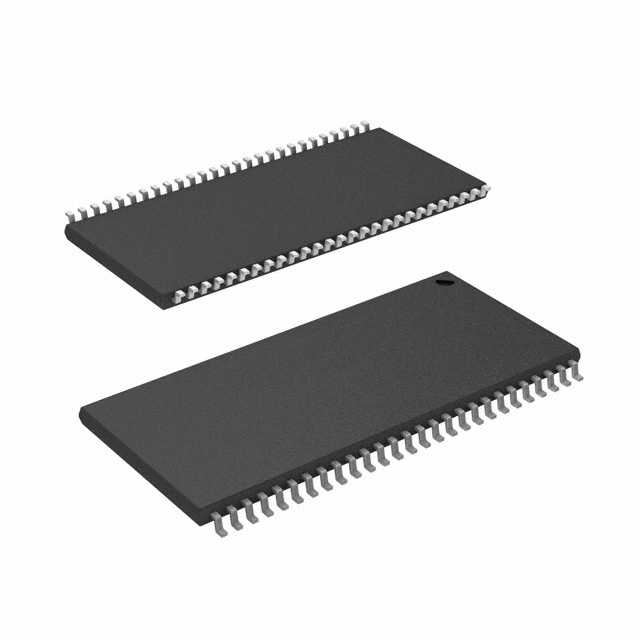Siehe Spezifikationen für Produktdetails.

AS4C32M16SB-7TINTR
Product Overview
Category
AS4C32M16SB-7TINTR belongs to the category of semiconductor memory products.
Use
It is primarily used as a storage component in electronic devices such as computers, smartphones, and other digital systems.
Characteristics
- High-speed performance
- Large storage capacity
- Low power consumption
- Reliable data retention
- Compact package size
Package
AS4C32M16SB-7TINTR is available in a small outline, thin profile (TSOP) package. This package ensures easy integration into various electronic devices.
Essence
The essence of AS4C32M16SB-7TINTR lies in its ability to store and retrieve digital information quickly and efficiently.
Packaging/Quantity
AS4C32M16SB-7TINTR is typically packaged in reels or trays, with each reel or tray containing a specific quantity of memory chips. The exact packaging and quantity may vary depending on the manufacturer's specifications.
Specifications
- Part Number: AS4C32M16SB-7TINTR
- Memory Type: Synchronous DRAM (SDRAM)
- Organization: 32M words x 16 bits
- Operating Voltage: 3.3V
- Speed Grade: -7
- Temperature Range: Industrial (-40°C to +85°C)
- RoHS Compliance: Yes
Detailed Pin Configuration
AS4C32M16SB-7TINTR follows a standard pin configuration for SDRAM modules. The detailed pin configuration is as follows:
- VDD
- DQ0
- DQ1
- DQ2
- DQ3
- DQ4
- DQ5
- DQ6
- DQ7
- DQ8
- DQ9
- DQ10
- DQ11
- DQ12
- DQ13
- DQ14
- DQ15
- VSS
- NC
- A0
- A1
- A2
- A3
- A4
- A5
- A6
- A7
- A8
- A9
- A10
- A11
- A12
- A13
- A14
- A15
- /CAS
- /RAS
- /WE
- /CS
- VDD
Functional Features
- Burst mode operation for high-speed data transfer
- Internal pipelined architecture for efficient data access
- Auto-refresh and self-refresh modes for power-saving
- On-die termination (ODT) for improved signal integrity
- Programmable CAS latency for flexible performance optimization
Advantages and Disadvantages
Advantages
- High-speed performance enables faster data processing
- Large storage capacity accommodates extensive data requirements
- Low power consumption prolongs battery life in portable devices
- Reliable data retention ensures data integrity over time
- Compact package size allows for space-efficient integration
Disadvantages
- Sensitive to electrostatic discharge (ESD), requiring proper handling during installation or replacement
- Limited compatibility with older systems that do not support SDRAM technology
Working Principles
AS4C32M16SB-7TINTR operates based on the principles of synchronous dynamic random-access memory (SDRAM). It utilizes a clock signal to synchronize data transfers between the memory module and the system bus. The memory cells store digital information as charge levels, which are refreshed periodically to maintain data integrity.
Detailed Application Field Plans
AS4C32M16SB-7TINTR finds extensive application in various electronic devices and systems, including: - Personal computers - Laptops and notebooks - Servers and data centers - Mobile phones and tablets - Gaming consoles - Automotive electronics - Industrial control systems
Detailed and Complete Alternative Models
- AS4C32M16SB-7TCNTR
- AS4C32M16SB-7TCN
- AS4C32M16SB-7TCNTR-T
- AS4C32M16SB-7TCN-T
- AS4C32M16SB-7TCNTR-F
- AS4C32M16SB-7TCN-F
These alternative models offer similar specifications and functionality to AS4C32M16SB-7TINTR, providing flexibility for different design requirements.
In conclusion, AS4C32M16SB-7TINTR is a high-performance semiconductor memory product that offers large storage capacity, low power consumption, and reliable data retention. Its compact
Listen Sie 10 häufige Fragen und Antworten im Zusammenhang mit der Anwendung von AS4C32M16SB-7TINTR in technischen Lösungen auf
Sure! Here are 10 common questions and answers related to the application of AS4C32M16SB-7TINTR in technical solutions:
Question: What is AS4C32M16SB-7TINTR?
- Answer: AS4C32M16SB-7TINTR is a specific type of memory chip commonly used in technical solutions.Question: What is the capacity of AS4C32M16SB-7TINTR?
- Answer: AS4C32M16SB-7TINTR has a capacity of 32 megabits (Mb) or 4 megabytes (MB).Question: What is the speed rating of AS4C32M16SB-7TINTR?
- Answer: AS4C32M16SB-7TINTR has a speed rating of 7 nanoseconds (ns), indicating its access time.Question: What is the voltage requirement for AS4C32M16SB-7TINTR?
- Answer: AS4C32M16SB-7TINTR operates at a voltage of 3.3 volts (V).Question: What is the package type of AS4C32M16SB-7TINTR?
- Answer: AS4C32M16SB-7TINTR comes in a small outline, thin profile (TSOP) package.Question: Can AS4C32M16SB-7TINTR be used in embedded systems?
- Answer: Yes, AS4C32M16SB-7TINTR is commonly used in embedded systems due to its compact size and low power consumption.Question: Is AS4C32M16SB-7TINTR compatible with different microcontrollers?
- Answer: Yes, AS4C32M16SB-7TINTR is compatible with a wide range of microcontrollers that support the required interface.Question: Can AS4C32M16SB-7TINTR be used in high-speed data logging applications?
- Answer: Yes, AS4C32M16SB-7TINTR's fast access time makes it suitable for high-speed data logging applications.Question: Is AS4C32M16SB-7TINTR suitable for real-time processing tasks?
- Answer: Yes, AS4C32M16SB-7TINTR can be used in real-time processing tasks due to its low latency and fast access speed.Question: Are there any specific temperature requirements for AS4C32M16SB-7TINTR?
- Answer: AS4C32M16SB-7TINTR has an operating temperature range of -40°C to +85°C, making it suitable for various environments.
Please note that these answers are general and may vary depending on the specific technical solution and requirements.

